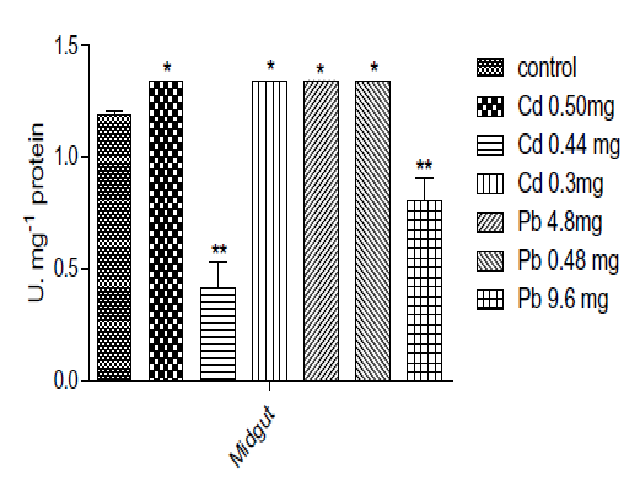Effect of Cadmium and Lead Exposure on Tissue Specific Antioxidant Response in Spodoptera litura
DOI:
https://doi.org/10.5530/fra.2016.1.11Keywords:
Metal toxicity, Spodoptera litura, Antioxidant enzymes, SOD, CAT, GST, ICP-MSAbstract
Introduction: Oxidative stress in insects may result from an imbalance of oxidants and antioxidants under a significant impact of metals. Reactive oxygen species (ROS), such as superoxide, hydrogen peroxide, and hydroxyl radical, are generated from normal metabolic processes in all oxygen-utilizing organisms. In the present study was designed to the impact of heavy metal (Cadmium and Lead) toxicity and its free radical scavenging enzymes in Spodoptera litura larvae. Methods: Heavy metals were administered using artificial diet method having different concentrations. The metal toxicity was observed after 24 and 48 hrs post treatment. In antioxidant parameters were SOD, CAT, POX, GST, LPO, ACP and AKP were assessed. In additionally metal accumulation analysis using ICP-MS. Results: In particular, after exposure to diets containing environmentally relevant concentration (Cd 0.3 mg, Cd 0. 44 mg, Cd 0.50 mg or Pb 0.48 mg, Pb 4.8 mg, Pb 9.6 mg) at 48 hrs changes in the activity of antioxidant enzymes were measured in larvae. The results showed that compared with control, the based on concentration significantly increased of antioxidant enzymes activities. In ICP-MS analysis results shows based on the concentration Pb 9.6 mg, 325.61 ppm/mg-1 and Cd 0.44 mg, 36.5 ppm/mg-1 will be increased. Conclusion: In conclusion antioxidant systems of S. litura were altered by Cd and Pb exposure as determined by measuring in the enzymes activities. All of Cd and Pb result in strong oxidative stress and toxicity to S. litura larvae. Based on the results we suggest that metal toxicity and metal accumulation of insects influenced by Cadmium chloride and Lead nitrate in S. litura larvae.
Downloads
Metrics





